|
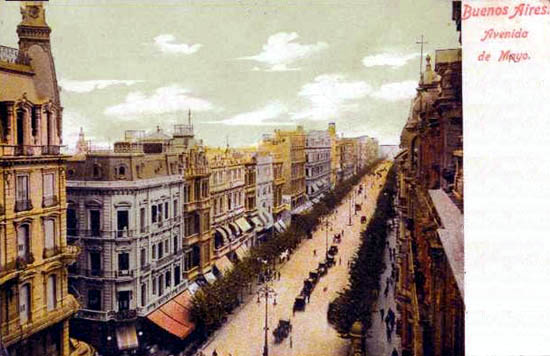
Avenida 25 de Mayo, approx. 1907.
In Buenos Aires, Butch, Sundance and Etta stayed at the Hotel Europe
at the corner of Calle Cangallo and Calle 25 de Mayo. While in
Buenos Aires, they applied for a land grant from the director of lands.
In October, 1901, they arrived in the Cholila Valley in Chubut Provence, where
they established a small estancia and store on the east side of the Rio Blanco. The area had been
settled by Welsh colonists. Stories of "Boots Cassidy" still live on in Chubut.
En español "Butch" may sound like "Boots."
In appearance the area is reminiscent of parts of
western Montana with the snow covered mountains in the distance. And like the areas to which Butch and
Sundance would retreat in the American West, it was isolated. At the time,
the area had a population of approximately 14. Indeed, even today, Cholila remains small and off the
beaten path, having a population of less than 1800 and served by el camino de grava, a gravel road.
A short distance out of town is a lake referred to by some locals as "Los Mosquitos."
Only a few years before the arrival of the trio, had a
determination been made as to whether the area was to be a part of Chile or Argentina. Yet,
Butch, Sundance, and Etta were not the first norte americanos to arrive in Chubut.
A few years before, a texano, claiming to be a former North American lawman and calling
himself Martin Sheffield, had settled in the Chubut Valley at Bariloche. Sheffield applied for permits to
prospect for gold, but the application was never acted upon by the Argentine
bureauracy. Sheffield was noted
for his prowness with two Colt revolvers which he always wore. By 1900, another
North American prospector, Charles H. Williams arrived upon the scene, but fled to Chile after a
fight in Ñorquinco, a small town in Rio Negro Provence. Five years later Williams returned to
shoot the clerk in the store.
Additionally, another
former North American lawman, John C. Perry, and his family settled in Cholila. Perry moved to the
area shortly after the turn of the century from Crockett County, Texas. In Texas, Perry
had served as postmaster of Ozona, a small town about 110 miles north of Del Rio. He, additionally,
served as sheriff of Crockett County from 1891, upon the county's formation, to 1894.
In January, 1922, Sheffield achieved world-wide fame when he wrote Dr. Clementi
Onelli, director of the Buenos Aires Zoological Gardens of his observation in the Nahuel Huapi Lake
of an animal of enormous weight with a swan-like head whose movement in the water reminded
Sheffield of a crocodile. Dr. Onelli had previously investigated sightings of possible living
plesiosaurs in Chubut. Reports of sightings had been made in 1897, 1907, and 1913. Not withstanding demands
by President Harding that the Smithsonian be permitted to conduct a new investigation and demands by
King George V that the British Museum sponsor the expedition to Chubut, Dr. Onelli proceeded with his own staff. At the
lake, the investgation was conducted by lobbing dynamite into the depths in an effort to
force the creature to surface. When the creature failed to appear, Dr. Onelli upon his entrance into the
Chubut town of Bariloche was greeted by a float depicting the animal. Sightings of the
alleged plesiosaur, now nicknamed "Nahuelito," seem to come about the beginning of
the tourist season. In 1932, Martin Sheffield disappeared.
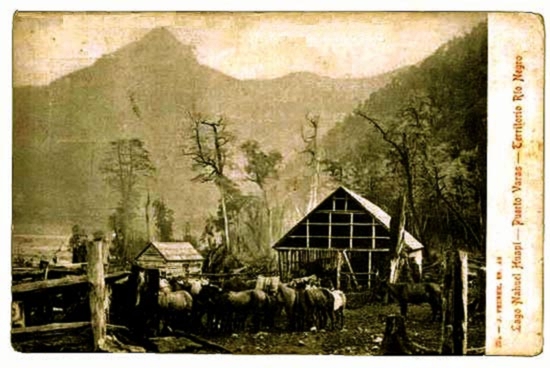
Lago Nahuel Huapi, Puerto Veras, Territorio Rio Negro
Sheffield's skeletal remains were discovered in the late
1930's along the Rio de las Minas where he had been prospecting for gold. Indentification was possible. The skeleton
still clutched the two Colt revolvers. Affidavits were filed a local justice of the peace by John Crockett and Oliverio Perry, the son of
John Perry, that Sheffield had died a natural death in 1932 while prospecting for gold and the two had buried Sheffield. Oliverio was, as were his
sister Minnie and brother Aveaden, born in Ozona. A younger brother, Edwardo, "Teddy," was born in
Argentina. Nevertheless, there has always been a lingering suspicion that Sheffield may have been killed for
gold that he had discovered.
Remain's of Butch and Sundance's Cabin, Cholila, Argentina.
Cassidy, in a letter to a friend in Vernal, Utah, described the estancia in
Cholila as having 300 head of cattle, 1,500 sheep and 25 horses. The cabin,
still in existence, was described as having four rooms. Additionly there were some sheds and a stable.
The closest town for supplies and for marketing the cattle was Cochamo, Chile, which was
reached by trailing the cattle over the Paso Cochamo, an ox trail laid out by Jesuits. Today, the trail is
a muddy horse trail. Cochamo, itself, remains small. In an area of Chile consisting of 700,000 hectares,
there are only 46 kms of graveled road and approximately 14 registered automobiles. There are,
however, about 7000 horses. Access at Butch and Sundance's time from the remainder of Chile and for the
shipping of meat was by sea.
In his letter, Cassidy expressed loneliness. Loneliness may have been exasperated by the
two absences of Sundance and Etta. On
two occasions Sundance and Etta returned to the United States, once
for a short visit in 1902, when Sundance was a guest at Dr. Pierce's Invalids'
Hotel and Surgical Institute at 663 Main St., in Buffalo, N.Y., returning to Argentina on the freighter
Soldier Prince. By May, the Pinkertons had received reports of the visit to the
hospital. Shortly thereafter, the Pinkertons had traced the trio to Buenos Aires.
Additionally, the Pinkertons had a full description of Etta or Ethel Place:
She is about 27 years old, five feet four inches in height, weighing about 110 pounds, medium complexion
and wears her brown hair on the top of her head in a roll from forehead. She
appears to be a refined type."
A second visit to the United States was in 1904.
The 1904 trip included a trip to the St. Louis Fair. In 1905, a seventh North American, Andrew Duffy, arrived upon the scene.
Chilean writer Luis Sepúlveda, writing in the French journal
LeMonde Diplomatique, September, 2004, contends that Sheffield was well aware of the identity of
Butch, Sundance, and Etta. Sheffield knew that the three were wanted by the Pinkertons, but
failed to report them. Nevertheless, by 1906, the Pinkertons had
traced Butch and Sundance to the Cholila Valley. It is believed that
in 1906 or 1907, Etta Place returned permanently to the United States, possibly to San
Francisco.
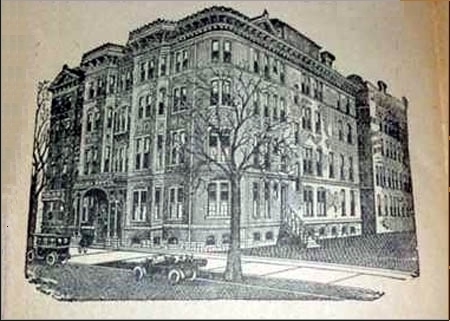
Dr. Pierce's Invalids' Hotel and Surgical Institute, Buffalo, New York.
Ray Vaughn Pierce, M.D (1840-1940), shortly after his graduation from
medical school in 1862 established the "World's Dispensary," in Buffalo, New York, which
specialized in patent medicines advertised on the roofs of barns. In 1876, he commenced the
construction of his hospital which combined the features of a luxury hotel and
a hospital. The hospital employed some 15 physicians and featured some of the newest advances
in medicine, being one of the first, as an example, to employ X-Rays. While the
hospital was under construction, Dr. Pierce wrote Alexander Graham Bell inquiring as
to the possibility of using Bell's newly invented telephone in lieu of speaking tubes in the
patients' rooms. Dr. Pierce also went through 19 printings of his
The People's Common Sense Medical Advisor, which by 1907 had sold over two million
copies. The result, however, of the promotion was that people from all over the
world beat a path to Dr. Pierce's door, some being turned away because of lack
of bed space. The indication, then, is that Etta and
Sundance were well-off, in that they could afford (and be accepted in) Dr. Pierce's
Hospital.
In Argentina, three bank robberies have been attributed
to Butch and Sundance: (a) the robbery on February 14, 1905, of the Banco de Londres y Tarapaca in Rio Gallegos some 700 miles south
of the Cholila Valley; (b) according to Sr. Sepúlveda, the subsequent robbery of the Banco del Sur in Santa Cruz Provence, the latter
allegedly by Butch, Sundance, and Duffy. Sr. Sepúlveda also noted the
surprise acquisition of newly found wealth by Sheffield following the
robbery; and (c) 1907 robbery of the Banco de Villa Mercedes. Additionally, it has been contended that
Butch and Sundance robbed the Mercantile Companía de Chubut store. It is highly unlikely that Butch and Sundance robbed the Mercantile. It was not established by
Welsh settlers until 1911.
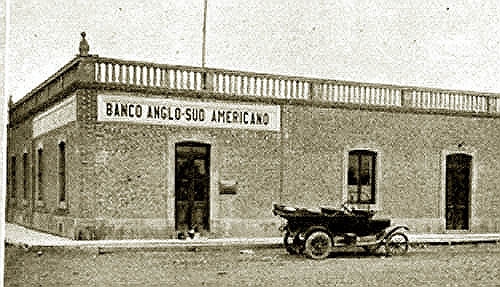
Banco Anglo-Sud Americano, (formerly the
Banco de Londres y Tarapaca), approx. 1920. The Bank changed its name in
1906 and failed during the Depression.
In 1905, Rio Gallegos, although small with a population of approximately 900, was prosperous, with two banks.
In addition to the British-owned Banco de Londres y Tarapaca there was the National Bank and
the modern Hotel Argentina, and the Club Progresso, a social club for the
well-to-do.
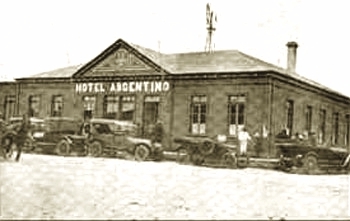 Hotel Argentina de Rio Gallegos, approx. 1920
Hotel Argentina de Rio Gallegos, approx. 1920
In January 1905, two distinquished-lookng North Americans named Brady and Linden, accompanied by a lady, checked into
the Hotel Argentina. They indicated they were looking for investments. Soon the
two men made a small deposit with the Banco de Londres y Tarapaca. Each day the men would gallop on their
horses across the center of town. This was regarded by the townspeople as a Yankee
eccentricity, which soon attracted no attention. On February 14, the two had breakfast at the
hotel and later lunch at the Farina Cafe. After lunch, the two proceeded into
the Bank and pulled colt revolvers on the bank manager, Arthur Bishop, and the teller, Alexander Makerrow.
The bank manager was forced to open the safe and place the money into a canvas tote bag.
In addition to the money in the safe, some £483 from a separate box was taken. The two
galluped out of town, exciting no particular interest until it was discovered that the
bank had been robbed. A posse gave pursuit and discovered winded horses and a place where apparently
the woman had kept fresh horses. The culprits were never caught.
Some writers believe that the three answered the descriptions of Butch Cassidy, the
Sundance Kid, and Ethel or Etta Place. Others believe that it is unlikely
that the three committed the robbery of the Banco de Londres y Tarapaca.
The estancia in Cholila was established by Butch, Sundance and Etta under the provisions of the
Argentine Homestead Act of 1884 which required that the three meet certain standards of
development. By pure happenstance, a governmental representative came the day following
the Banco de Londres robbery and confirmed the presence of the necessary cattle, horses,
etc. at the estancia. Thus, it is contended that Butch and Sundance had an alibi, and in all likelilood the
robbery was committed by two other pistoleros norte-americanos, Robert Evans and William Wilson. Evans and
Wilson were killed near the Chilean border in 1911. Interestingly as discussed on the next page,
by coincidence, "William Wilson" was
an alias used by Kid Curry while he was residing in Knoxville.
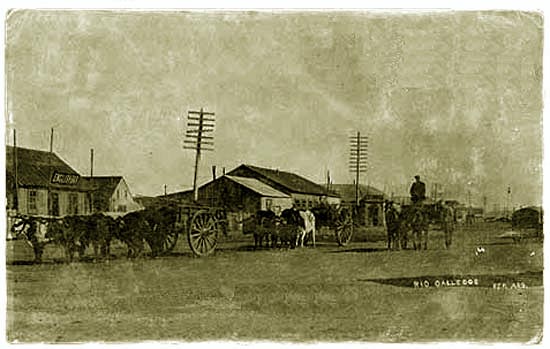
Rio Gallegos
Regardless of whether Butch and
Sundance committed the asalto upon the Bank,
Argentine authorities learned from the Pinkertons of the presence of the two in the country. Butch and
Sundance were alerted by a local official and fled to Chile, returning, however, to
rob the Banco de Villa Mercedes. They then moved on to Peru, and ultimately, as discussed on the next page, Bolivia.

Etta Place
There is no consensus as to the indentity of Etta Place or as to her
ultimate fate. Indeed, it is unclear as to whether her given name was "Etta," or, more likely,
"Ethel." Some contend that she was a school teacher, other contend
that she was a soiled dove from a house in San Antonio, possibly from Fannie Porter's sporting parlor on
the corner of Durango and South San Saba, or perhaps using the name Ethel Bishop from the Widow Sewell's facility at 212 South Concho.
Members of the Wild Bunch were known to frequent Mrs.
Porter's establishment for a little bit of rest and recreation. Indeed, as late as 1941, there were some 425 "ladies" doing business
within the district and checking into a free clinic at 513 1/2 Delorosa. It gives new neaning to Bob Wills' song about a "rose of old San Antone."
Certainly, the area south and west of San Pedro Creek provided an
opportunity for members of the Wild Bunch to work off energy and loneliness. Not withstanding that the
oldest profession was a violation of Texas law, the facilities were
licensed by the City of San Antonio. The license fee was $500.00. Most of the houses were
in the 100 to 500 block of Matamoros, the 200 to 500 block of South Concho, and the
100 block of Monterey. There were "Class A" facilities in which the charge was
$5.00 and up, "Class B" from $2.50 to $5.00 and finally "Class C" under $2.50. In the early
1900's a directory of the houses, the "Blue Book," was available to tourists.
Not withstanding licensure by the City, patronage at the various places within the district had a
certain degree of peril. Lawyer Sidney M. Staniforth died of two bullet wounds to the head in an upstairs room of
Ignacia Corez's bagnio. Two physicians testified that either wound would have caused complete
and instantaneous paralysis. According to the New York Times, July 14, 1885, Staniforth had been
warned that there were dangerous and desperate men frequenting the area. Nevertheless, Staniforth's death
was ruled "suicide." Wild Bunch member Camilla Hanks, "Deaf Charlie," bought the
course at Flo Williams's "boarding house," three blocks from the Porter establishment. As expressed by Charley F. Eckhardt,
Tales of Badmen, Bad Women and Bad Places, Texas Tech University Press, 1999, Deaf Charlie had "three holes in him. One of 'em made the other
two not worth patching." Harvey Logan met Annie Rogers at the Porter facility. The
last known visit to the Widow Porter's by members of the Wild Bunch was in 1901.
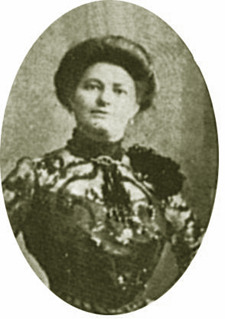 Fannie Porter Fannie Porter
Another theory is that Ethel Place maintained a boarding house at 511 E. 4th Street,
Ft. Worth prior to meeting Sundance in October, 1900. It has also been argued that Etta was the
illegitimate daughter of a New Mexico remittance man, George Arthur Ingerfield Capel. This was, depending on the teller of the
story, as a result of an "association" with either a Mexican senorita in New Mexico or the sister
of Moreton Frewen in Ireland. If the later, Sundance would have been a cousin-in-law by marriage to Sir Winston Churchill.
Capel was, himself, the illegitimate son of the Sixth Earl of Essex.
The latter story has Capel moving to Wyoming and, going by the name "Ingerfield," engaging in the
second-hand cow business out of the Hole-in-the-Wall. There, he organizes the gang and lays out the
Outlaw Trail so that the second-hand cattle could be trailed to Brown's Hole. Young Etta, yearning for
her father, at age 13, ran away from Ireland and to Wyoming came. The story is likely the confusion of Capel's
middle name "Ingerfield" with one of Butch Cassidy's numerous aliases. Allegedly, Capel was ambushed in
1892 near Tombstone, Arizona Territory.
A theory has been put forth that following
Sundance's death, Etta was known as Eunice Gray and maintained a hotel in Ft. Worth at 110 E. 15th St and died in 1962 at
age 77. This theory seems unlikely in that it would put Etta at age 16 when
she was in New York for the photo on the previous page. Another contention has been put forth that
Etta was Annie Bassett, the "Queen of the Rustlers," from Brown's Hole, Colorado. Under this
theory, Ann Bassett met Sundance when he was hiding out in Brown's Hole, and that the
two resided together for a period of time in Robber's Roost, Utah. The theory notes that the
Vernal Express reported on February 2, 1901, that Miss Annie Bassett left that morning on the
stage for Texas. The theory also notes that Ann Bassett returned to Brown's Hole about 6 months after July 1902, after having traveled for the
previous two years. The difficulty with the theory is that Etta Place was in New York with Sundance in
January of 1901 and, thus, could not have departed on the stage in February
1901. Additionally, Henry and Etta Place returned to Argentina in 1902. Thus, Etta could not
have been in Brown's Hole at the beginning of 1903. It has been contended that following the departure from Cholila,
Etta returned to the United States, either to San Francisco, Denver, or maybe Oregon. It has also
been argued that she returned to Chubut and was killed near El Bolson in a shootout with Mateo Gebhart, an Austrian officer in
the Argentine Gendarmeria or border police. Gebhart, also spelled Ghebart or Gherbard, arrived
in Patagonia in 1911 ostensibly to fight Yankee brigands. But by 1911 most of the brigands were
dead. He, therefore, turned his attentions to Chileans and local residents with such a vengence that
he was referred to as "una vergüenza nacional" ("a national shame").
Tracking Etta by name would be an impossible task. The ladies within the district west of the
creek in San Antonio stayed for only a short time and used ficticious names. Names might be
changed as often as the sheets. One later residing next door to Mrs.
Sewell's boarding house,used the name "Legal Tender." We, of course, have no way of knowing Miss Tender's real name.
The same difficulty
also exists with regard to members of the Wild Bunch. Names were changed frequently. As one
Texas rancher Buster De Graftenried observed of a cowboy called "Boots" who signed on with
De Graftenried's Pig Pen outfit, "You never asked a fellow his name and if he told you,
you wouldn't believe it anyhow." One day one of the men disappeared. Boots was dispatched on one of the
outfit's best horses to find the missing man. Boots failed to return. The next day, the sheriff appeared.
"Well, I never heard what happened to Boots for about two year," De Graftenried related. "One day a letter come and
said that he still had the pony and that he was sick and that he wondered if he had
worked for us long enough to have anything coming. Well, I looked on the books,
and shore nuff I owed Boots $40.00, so I sent him a check for $40.00. He just signed his
name Boots in the letter. So I made out the check to Boots and he signed it Boots and by
golly he got the money. A few years later he came past our place and stayed all night. on his way to
Arizona in another big hurry. He sure was the right kind of fellow. He knew how to keep his
mouth shut. He shore could have anything on that ranch. He just didn't talk too much. He was just a good cowboy"
Next page: Butch and Sundance in Chile and Bolivia.
|